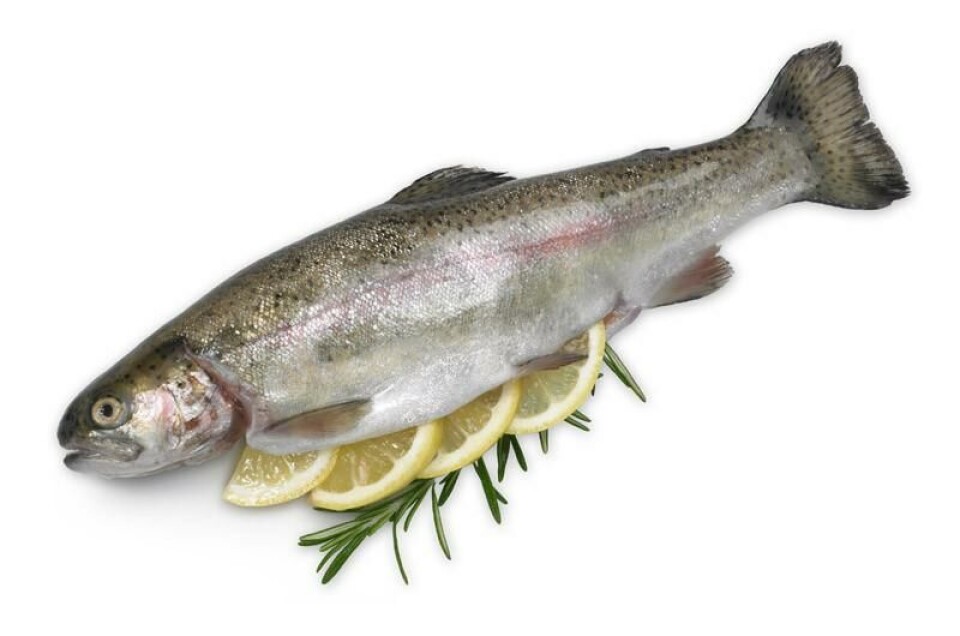
Portion trout farmers face tough choices as markets disappear
Portion trout producers in the UK are facing the possibility of culling healthy fish because of the Covid-19 pandemic’s effect on markets.
Like salmon producers, trout growers have lost nearly all their export and food service customers because of the epidemic’s impact on international flights and the closure of pubs and restaurants.
The salmon industry’s sales losses have been mitigated by an increased demand from supermarkets, but the opposite is true for trout farmers.

Reduced product range
Bulk buying by consumers and the fear that sickness and self-isolation could lead to staff shortages has led supermarket chains to reduce the range of products they carry to simplify their supply chain and create space for more of the products they know are in demand.
Tesco and Sainsbury’s closed their wet fish counters in March so they could redeploy staff to other areas where they were needed. Asda had already announced closure of its wet fish counters in January, before Covid-19 became an issue in Europe, and many independent fishmongers have also closed during the lockdown that has been imposed to prevent the spread of the virus.
No market access
As a result of these factors, portion trout – fish weighing between 300-500 grams sold gilled and gutted or as fillets on fish counters - have almost no market access and fish are being kept on a maintenance diet.
The lockdown restrictions also mean that trout normally supplied to angling fisheries are staying on the farm. The fisheries have remained open, but anglers aren’t allowed to drive to them to fish.
Simon Duffin runs Invicta Trout Ltd at Newtonairds, Dumfriesshire and Loch Venacher in the Trossachs, producing around 450 tonnes of trout annually, roughly half of which is for the table and half for restocking fisheries.
Decisions on whether the business may have to cull fish depend on the market, the possibility of anglers being allowed to drive to fisheries and the weather. Bright, hot days do not suit trout inland farming.
The river above Invicta’s farm in Dumfries is shaded by trees which keep the water cooler but the site is dependent on a spate river for its water supply, and if the weather stays dry that could create a problem.
The farm in the Trossachs has a plentiful supply from Loch Vanacher but the water temperature tends to rise on sunny days.
“We switch on the oxygen but from an animal welfare perspective it would be better to have fewer fish on the farms,” said Duffin, who has not been able to sell fish for almost a month.
While trout farmers can keep market-ready fish on a maintenance diet, they can’t do the same with juveniles.
‘They will eat each other’
“The problem with little fish is that you have to keep them growing otherwise they will eat each other,” explained Duffin.
Eventually farms will run out of room, and that’s when difficult decisions may have to be made.
Duffin would like to see the fisheries opened up and the supermarkets begin taking trout again.
“If you could drive to go fishing, the fisheries would open up tomorrow. It is a very easy fix,” he said.
Processors
Persuading supermarkets to put portion trout back on the shelves is more difficult, he said, as trout growers don’t deal directly with the retailers.
“We are the customers of the processors,” he said.

Oliver Robinson, chief executive of the British Trout Association, said trout farmers across the UK were all facing problems, but those growing portion trout and fish for the restocking market were currently harder hit than those using marine sites to produce larger trout.
Restocking accounts for 3,000 tonnes of the 17,000 tonnes a year produced by the trout industry, and fisheries normally buy the stock in April, May and June.
Some fisheries had been “incredibly helpful” and had taken some fish for health and welfare reasons, even though they had no angling customers.
It is the processors who have the levers to get the fish back into supermarkets, said Robinson.
Chilled shelves
“Two of the supermarkets have decided to de-list portion trout for good. We have a lot of fish on the farms,” said the executive.
“What we need is to turn the supermarkets around to put trout on the chilled shelves. Take the fish and see if people will take them.
“The business-critical situation and the potential demise of the portion trout throughout the UK rests with the processors and the markets and the biggest volumes in the markets are the supermarkets.
“We do not deal directly with the supermarkets, it is the processors who deal with them.”
Hardship fund
Robinson stressed that the BTA had been talking with the Scottish government for several weeks and that rural economy secretary Fergus Ewing has been “absolutely fantastic”.
In practical terms, regulators in Scotland and England had both made moves to help keep fish healthy by allowing more extraction from water sources, among other things.
Last week the Scottish government announced a £3 million hardship fund for trout growers and shellfish farmers, entitling them to grants of up to £27,000 depending on previous income.
EMFF funding
Robinson is hoping something similar can be provided for trout farmers south of the border.
The BTA has also asked the UK government if it’s possible to gain access to European Maritime and Fisheries Fund allowances of up to €120,000 per aquaculture business.
He is also asking for trout growers to get help to meet the massively increased cost of air freighting fish to export markets.






















































